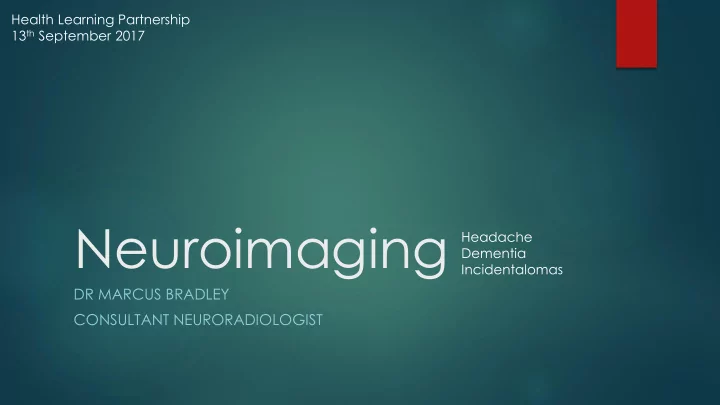

Health Learning Partnership 13 th September 2017 Neuroimaging Headache Dementia Incidentalomas DR MARCUS BRADLEY CONSULTANT NEURORADIOLOGIST
Dr Marcus Bradley Consultant Neuroradiologist Interventional Neuroradiologist Consultant NBT 2008 – Lead Neuroradiologist 2011 – 2014 Training Program Director 2011 – 2017 NHSE Specialised Imaging CRG Specialised 2013 – 2016 Chair Imaging Clinical Governance 2014 – SW Senate Assembly Member 2014 –
Glioblastoma Multiforme
Schedule Neuroradiology Headache Dementia Incidentalomas
Subarachnoid Haemorrhage
Neuroradiologists Neurointervention Tertiary Neuroimaging Coiling cerebral aneuryms Neurosciences Thrombectomy for acute stroke Second Opinions MDTs Medicolegal Other procedures Neuro-oncology Epilepsy Vertebroplasty Paediatrics Wada Neurovascular Radionuclide Dementia Training Spine Radiology and non-radiology Stroke
Headache Characteristics Pathology
NICE Guidelines Suspected Cancer: recognition and referral NG12 updated July 2017 1.9 Brain and CNS Headache CG150 updated November 2015 Tension / Migraine / Cluster Menstrual-related Migraine with aura Medication overuse
Evaluate and Consider worsening headache with fever headache triggered by cough, valsalva (trying to breathe out with nose and mouth blocked) or sneeze sudden-onset headache reaching maximum intensity within 5 minutes headache triggered by exercise new-onset neurological deficit orthostatic headache (headache that changes with posture) new-onset cognitive dysfunction symptoms suggestive of giant cell arteritis change in personality symptoms and signs of acute narrow angle glaucoma impaired level of consciousness a substantial change in the characteristics of their headache. recent (typically within the past 3 months) head trauma
Consider compromised immunity, caused, for example, by HIV or immunosuppressive drugs age under 20 years and a history of malignancy a history of malignancy known to metastasise to the brain vomiting without other obvious cause
Arachnoid Cyst
Do not… Do not refer people diagnosed with tension-type headache, migraine, cluster headache or medication overuse headache for neuroimaging solely for reassurance
Calcified Meningioma
2ww Consider an urgent direct access MRI scan of the brain (or CT scan if MRI is contraindicated) (to be performed within 2 weeks) to assess for brain or central nervous system cancer in adults with progressive, sub-acute loss of central neurological function
Basal Ganglia Calcification
Kernick, BJGP, 2008
Vestribular Schwannoma
Cerebral Aneurysm
Anaplastic Astrocytoma
Dementia subtypes Alzheimer’s Disease Fronto-Temporal Dementia Behavioural Language Progressive Non-Fluent Aphasia Semantic Logopaenic Lewy Body Disease Vascular Dementia Prion Disease
AD or SD or FTD or HSE or RTA
“Diagnosis of subtype of dementia should be made by healthcare professionals with expertise in differential diagnosis using international standardised criteria” Type Recommended diagnostic criteria 1 Prefer NINCDS/ADRDA criteria. Alzheimer's disease Alternatives include ICD-10 and DSM-IV. Prefer NINDS-AIREN criteria. Vascular dementia Alternatives include ICD-10 and DSM-IV. International Consensus criteria for Dementia with Lewy bodies (DLB) DLB. Lund – Manchester criteria, NINDS Frontotemporal dementia (FTD) criteria for FTD.
Imaging in Dementia Exclude other pathology NOT needed Establish subtype Moderate / Severe Dementia Diagnosis Clear MRI vs CT HMPAO SPECT FTD vs AD vs VaD DAT SPECT DCLBD
What is Vascular Dementia? Multi-infarct Atherosclerosis Strategic Infarct Small Vessel Disease Subcortical Cerebral Amyloid Angiopathy
Parenchymal Haematoma
What you tell us
40M persistent occipital headache several months- now daily
Chronic Subdural Haematoma
24F worrying features of memory loss and word finding difficulties worse in last 6 months, now disabling as becoming reclusive as unable to hold conversations, bloods- normal, no headaches, no vomiting, well in self, ? SOL/ other intracranial pathology
37M head injury in rta 2m ago. Possibly mild concussion Cousin recently had brain tumour. No vom or neurology. Hx spondyloarthropathy. Daily headache since injury
55M 8m of daily episodes of deja vu with dread and witnessed vacant expresion and lip smacking. ?fit disorder. ?SoL
Acute Subdural Haematoma
41M URGENT PLEASE. ?SOL. 4 day h/o left sided headache with intermittent right visual loss. Never had headaches before. Associated with nausea.
84F coronal views please. memory worsening over the past year. short term memory difficulty. hx of HTN. please to assess further. CT will be helpful with assessment of dementia type, leading medication options. many thanks
84F report No focal mass lesion, haemorrhage or surface collection seen. There is moderate generalised involutional change with more focal atrophy affecting the temporal structures bilaterally.
Pineal Calcification
55M dizziness and headache intermittently for 1-2 months. No pattern. Not positional. Feels nauseous. r/o SOL
81M URGENT: known dementia, but recent rapid decline. Has had falls. Less coordinated, harder to walk and follow instructions. More confused. ?subdural
81M report No intracranial haemorrhage or collection. No evidence of recent infarction. There is extensive frontal, parietal and right medial temporal volume loss. The left medial temporal lobe is less severely affected. The imaging is compatible with a diagnosis of AD or FTLD.
Cavernous Haemangioma
42F head injury oct 16 with concussion. heavy fence post fell onto her head. neck pain and headaches since then, much more acute headache now with some light sensitivity. No fundal changes but could she be scanned urgently?
69M getting regular focal migraines which hadn't had since he was 20
88F SOON PLEASE - many thanks Coronal views please Cognitive decline over this past year, hx of HTN. Also new intention tremor, is bilateral however. Reduced mobility over the past 2 months. No focal weakness. Hx of breast cancer. ? cause ? atypical dementia ? space occupying lesion ? other. with many thanks.
88F report No focal intraparenchymal mass lesion, haemorrhage or surface collection seen. Mild small vessel ischaemic change but with evidence of an old infarct in the region of the left globus pallidus. Moderate generalised involutional change with no particular focal atrophic element. There is an extra-axial calcified lesion on the left side of the foramen magnum likely to represent a small meningioma.
Questions
Recommend
More recommend